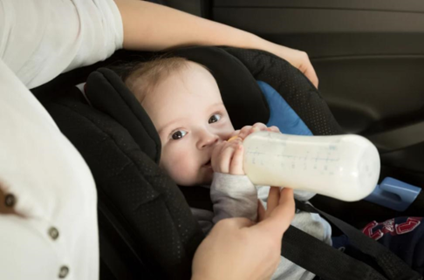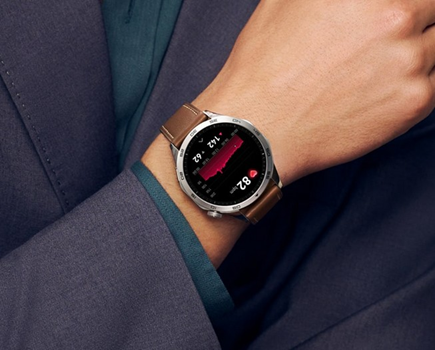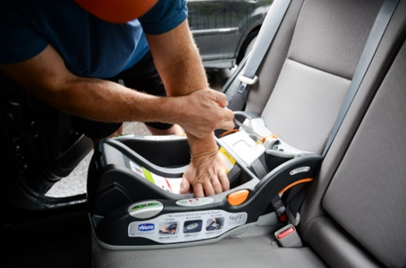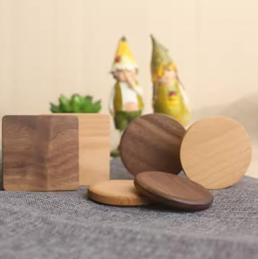Is It Safe to Feed a Baby in a Car Seat?
Feeding a baby in a car seat is a topic that generates mixed opinions. While some parents may feel it’s a convenient solution, safety should always be the primary concern. Car seats are specifically designed to protect infants during travel, not for use as a feeding chair. The risk of accidents, combined with the baby’s vulnerable position, makes feeding in a car seat less than ideal. It is essential to understand the risks associated with feeding in a car seat to ensure that your baby’s safety and comfort are never compromised.
Risks of Feeding a Baby in a Car Seat
Choking Hazards
One of the most significant risks of feeding a baby in a car seat is the possibility of choking. Babies have small, delicate airways, and any sudden motion from the car can cause them to gag or choke on food. The car’s movement can disrupt the baby’s swallowing process, especially when the baby is not in an ideal feeding position. Even a slight bump or sudden stop can increase the risk of improper swallowing. To avoid choking hazards, it’s best to avoid feeding while the car is moving, particularly with bottles or solid foods.
Posture and Breathing Concerns
While car seats are designed to secure your baby safely, they are not always the best for feeding. A baby’s posture can be compromised in a car seat, which may lead to difficulty swallowing and breathing. The reclined angle of the seat can make it harder for your baby to feed comfortably, and their head may not be fully supported. This improper positioning can also increase the risk of reflux or discomfort. It’s important to ensure the baby’s head and neck are well supported, but this is difficult to manage effectively in a moving vehicle.
Distractions for the Driver
Feeding your baby in the car can also be a distraction for the driver, which increases the likelihood of accidents. Parents may find themselves focused on their baby’s feeding rather than the road, taking their attention away from driving. This divided focus can lead to dangerous situations for all passengers. Ensuring that the driver remains fully attentive is crucial. If feeding is necessary during travel, consider stopping at a safe location to avoid any distractions while driving, as safety should always come first.
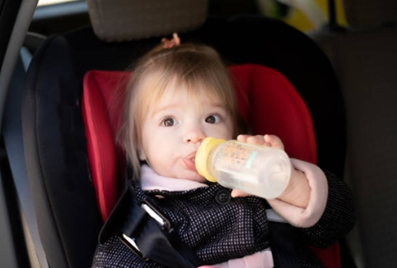
When Can You Feed a Baby in a Car Seat?
Guidelines for Feeding During Long Trips
If you are planning a long journey, it’s essential to plan feeding breaks ahead of time. Instead of feeding while the car is moving, schedule stops where you can feed and burp the baby in a safe, stable environment. This allows the baby to digest their food properly, reducing the risk of choking or discomfort. Regular breaks also help the baby stay calm, comfortable, and relaxed, which is important during longer trips. Aligning feeding times with your baby’s routine ensures they are well-fed without compromising their safety during travel.
Alternatives to Feeding While Traveling
Consider adjusting your travel schedule around your baby’s feeding times. Feeding the baby right before you leave or during planned breaks is an ideal alternative to feeding in a moving vehicle. If the trip is long, you can prepare bottle feeds or express breast milk in advance to be given when you stop. Additionally, providing a pacifier can help soothe your baby and prevent hunger-related distress without the risks associated with feeding in a car. Using these alternatives ensures that both you and your baby are comfortable and safe throughout the journey.
Tips for Feeding a Baby in a Car Seat Safely
Always Stop the Car Before Feeding
The simplest yet most effective tip for feeding a baby safely in a car seat is to always stop the car before feeding. Find a safe, stationary location to park the car, then feed your baby. This ensures that the baby is in a stable, secure environment during feeding, reducing the risk of choking or any other feeding-related accidents. Stopping the car also allows the driver to stay focused on the road and avoid any distractions that could lead to a dangerous situation. Always prioritize safety by pulling over before feeding your baby.
Use Proper Positioning and Support
When feeding your baby in a car seat, proper positioning is key to ensuring safe swallowing and breathing. Make sure the baby’s head is elevated to help with easy swallowing and digestion. Holding your baby upright and supporting their neck and head properly can significantly reduce the risk of discomfort or choking. A well-supported baby can feed more efficiently and comfortably. It’s important to remain vigilant and avoid feeding while driving, as it becomes difficult to ensure proper positioning in a moving car.
Conclusion
Feeding a baby in a car seat requires thoughtful consideration of safety factors. Although it may seem convenient, can you feed a baby in a car seat while the car is moving poses serious risks, including choking, poor posture, and distractions for the driver. To keep your baby safe, always stop the car before feeding and ensure proper positioning. Consider alternatives such as feeding before or during breaks, and prioritize safety above convenience. By following these guidelines, you can make your trips safer and more enjoyable for both you and your baby.
FAQ
Can I bottle-feed my baby in a car seat?
It’s not recommended to bottle-feed a baby in a moving car. The risks of choking and improper feeding posture increase significantly. Always stop the car before feeding the baby.
Is it okay to feed my baby solids in a car seat?
Feeding solids in a car seat is not safe due to the high risk of choking. It’s better to stop the car and ensure the baby eats in a secure and stable environment.
What is the safest way to feed a baby in a car seat?
The safest way is to stop the vehicle, position the baby properly, and then proceed with feeding. Follow proper guidelines for positioning to ensure the baby’s comfort and safety.

